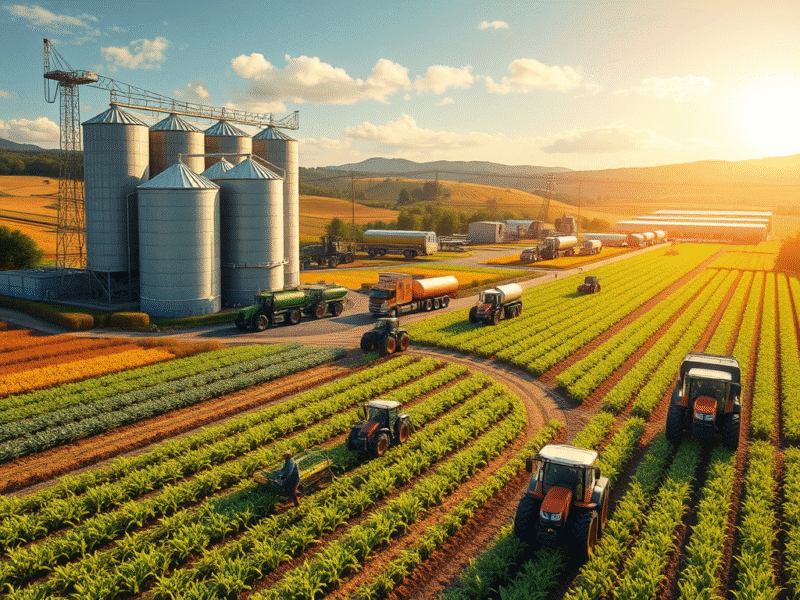Agriculture Supply Chain Management (ASCM) is crucial for the global food system, ensuring fresh, safe, and sustainable food from farm to fork. Explore its components, challenges, technological innovations, and future trends in this insightful overview.
Agriculture Supply Chain Management (ASCM): From Farm to Fork
Agriculture supply chain management (ASCM) is the backbone of the global food system, orchestrating the journey of agricultural products from the fields to your plate. It’s a dynamic process that integrates farming, processing, logistics, and marketing to deliver fresh, safe, and sustainable food. This article dives deep into ASCM, exploring its components, challenges, technological innovations, and future potential—all woven together with original insights and real-world examples.
Understanding Agriculture Supply Chain Management
At its essence, ASCM is about managing the flow of goods and services from the farm to the consumer. It’s a complex web of activities—cultivating crops, storing harvests, processing raw materials, and distributing finished products—all while balancing efficiency, quality, and sustainability. Picture it as a relay race: each participant must pass the baton flawlessly to win. In ASCM, that baton is food, and the stakes are high—feeding billions while minimizing waste and environmental impact.
Key Components of the Supply Chain
The agriculture supply chain is a series of interconnected stages. Let’s break it down:
- Production: This is where it all begins—farmers plant seeds, nurture crops, or raise livestock. Success here hinges on soil management, irrigation, and sustainable practices. It’s the foundation of the entire chain.
- Storage and Transportation: Once harvested, products need safe storage—think refrigerated silos for dairy or ventilated barns for grains. Transportation follows, moving goods to processing plants or markets without compromising quality.
- Processing and Packaging: Raw produce transforms into consumer-ready goods here. Vegetables are washed and chopped, milk is pasteurized, and everything is packaged to extend shelf life and appeal to buyers.
- Marketing and Selling: This stage bridges producers and consumers. Whether through supermarkets, farmers’ markets, or online platforms, effective marketing ensures products find their audience.
- Consumption: The finish line—consumers buy and enjoy the products. Feedback from this stage shapes future production, closing the loop.
Each step is a cog in a larger machine, and misalignment anywhere can stall the whole process.
Challenges Facing ASCM
The agriculture supply chain isn’t a smooth ride. It faces several roadblocks:
- Perishability: Fruits, vegetables, and dairy spoil fast. A delay in transit can turn profit into loss overnight.
- Weather and Climate Impacts: Droughts, floods, and storms disrupt harvests. Climate change amplifies these risks, making planning tougher.
- Market Volatility: Prices fluctuate with supply and demand. A bumper crop might crash prices, while a shortage spikes them.
- Labor Shortages: Farming and processing rely on skilled hands, but rural labor pools are shrinking.
- Sustainability Concerns
Consumers want eco-friendly food, pressuring the chain to cut carbon footprints and waste.
These hurdles test the resilience of ASCM, but they also spark innovation.
Technology’s Role in Revolutionizing ASCM
Modern tools are turning challenges into opportunities. Here’s how technology is reshaping the game:
- AI and Data Analytics: Artificial intelligence predicts demand and optimizes inventory. Farmers can use AI to decide how much to plant based on market trends.
- IoT (Internet of Things): Sensors track soil moisture, truck temperatures, and more in real time. This visibility prevents spoilage and boosts efficiency.
- Blockchain: A digital ledger traces products from farm to store. It’s a trust-builder—consumers know exactly where their food comes from.
- Automation and Robotics: Robots harvest crops and pack boxes, cutting labor costs and speeding up processes.
These advancements aren’t futuristic—they’re here, streamlining ASCM today.
Real-World Examples in Action
Let’s see ASCM at work:
- Blockchain Transparency: FreshLeaf Co., a U.S.-based salad producer, uses blockchain to track lettuce from fields in Arizona to supermarket shelves. Shoppers scan a code and see the harvest date, farm location, and transit path—proof of freshness and accountability.
- AI Optimization: AgroSmart, a startup in India, uses AI to forecast mango yields. By analyzing weather and soil data, it tells farmers when to pick and how to distribute, slashing waste by 25%.
These stories show ASCM isn’t just theory—it’s delivering results.
The Future of ASCM
What’s next for agriculture supply chain management? Here are trends to watch:
- Digital Transformation: More farms will adopt tech like AI and IoT as costs drop, making smart farming the norm.
- Sustainability Push: Expect greener practices—think renewable energy in transport or compostable packaging.
- Collaboration Boom: Partnerships between farmers, tech firms, and retailers will pool resources and innovation.
The future isn’t just about feeding people—it’s about doing it smarter and kinder to the planet.
Conclusion: Sowing Efficiency, Reaping Success
Agriculture supply chain management is more than logistics—it’s the lifeline of our food system. By mastering its components, tackling its challenges, and harnessing technology, we can ensure food reaches tables efficiently and sustainably. From blockchain-tracked spinach to AI-optimized orchards, ASCM is evolving fast. As consumers, producers, or innovators, we all have a stake in this journey. The question is: how will you help shape its future?




Leave a Reply